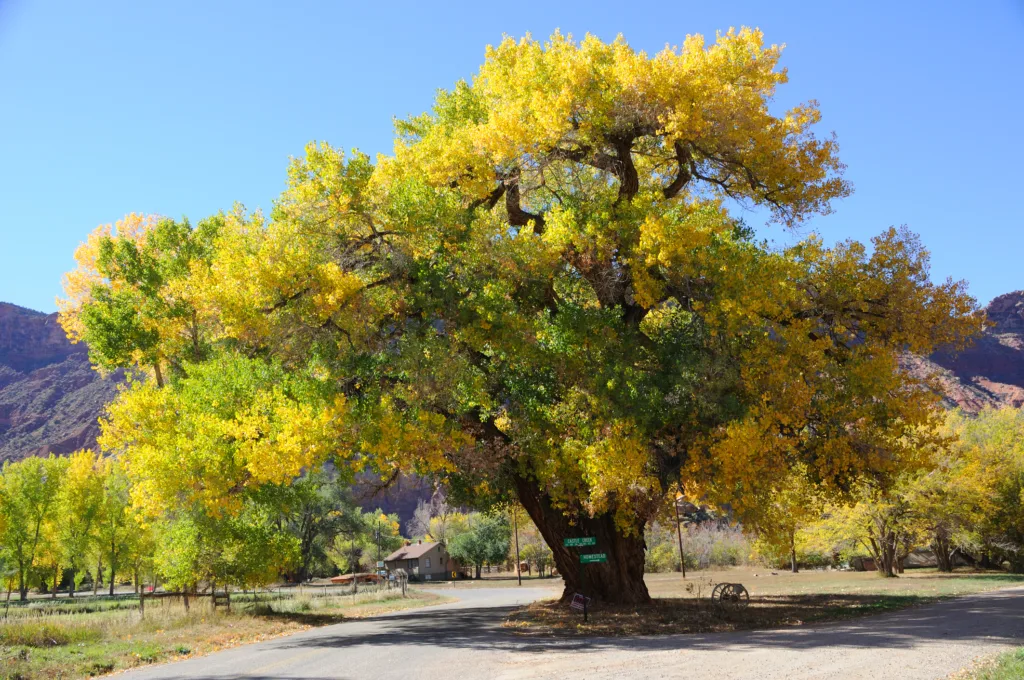The star in the cottonwood tree is a unique and fascinating symbol that has been revered by Native Americans for its sacred significance. This star shape is actually the pith of the cottonwood tree, whch serves as the central channel for transporting vital nutrients to twigs and leaf buds. The star shape is common to trees of the willow family, which include cottonwoods, aspens, willows and poplars.
Of all these trees, it is the cottonwood that holds a special place in the hearts of many Native Americans. The stars are found by snapping the small dry twigs which have fallen from a cottonwood tree. Look for the growth wrinkles in the bark. There will often be several on one twig. The wrinkles look a little like the wrinkles in a flex soda straw.
Cottonwood trees are known for their fast growth, and can add up to 6 feet in height each year, making them the fastest growing trees in North America. They belong to the same genus as other poplar trees, and produce seeds with a fluffy, white casing. Cottonwoods most often release seeds in the spring and early summer months.
The star in the cottonwood tree has been associated with various meanings and interpretations by different cultures and traditions. In Native American culture, the star is often seen as a symbol of hope, guidance, and protection. It is believed to represent the connection between the physical and spiritual world, and is often used in healing and spiritual rituals.
The star in the cottonwood tree has also been associated with the concept of renewal and rebirth. The tree sheds its leaves in the fall, only to grow new ones in the spring. This cycle of growth and renewal is seen as a metaphor for the cycle of life and death, and is often used as a symbol of hope and optimism.
The star in the cottonwood tree is a powerful and meaningful symbol that has been revered by many cultures and traditions for its sacred significance. Whether seen as a symbol of hope, renewal, or connection to the spiritual world, the star in the cottonwood tree serves as a reminder of the beauty and mystery of the natural world, and the profound wisdom and insight that can be gained from it.
Why Is There A Star In A Cottonwood Tree?
The star shape in a cottonwood tree is actually the pith of the plant, which plays a vital role in transporting essential nutrients to twigs and leaf buds. This star shape is a characteristic feature of trees belonging to the willow family, including cottonwoods, aspens, willows, and poplars. Among these trees, cottonwood holds a significant place in the sacred symbolism of many Native American tribes. The star shape in a cottonwood tree is a fascinating aspect of its biology and serves as an excellent example of the intricate connections between form and function in the natural world.

Does A Cottonwood Tree Have A Star Inside?
A cottonwood tree does not have a star inside. However, small dry twigs which have fallen from a cottonwood tree can be used to find stars. These stars are created by snapping the small dry twigs and looking for the growth wrinkles in the bark. These wrinkles can often be found on several twigs and resemble the wrinkles in a flex soda straw. By snapping the twigs and examining the wrinkles, one can create a “star” shape using the twigs.
What Is Special About A Cottonwood Tree?
Cottonwood trees are unique in several ways. Firstly, they are dioecious, meaning that they have separate male and female trees. The female trees produce a fluffy cotton-like substance that gives the tree its name. Secondly, cottonwood trees are considered the fastest-growing trees in North America, as they can grow up to 6 feet in height every year. Additionally, cottonwood trees are known for their ability to thrive in wet soils, making them popular choices for erosion control and stream bank stabilization. cottonwood trees are special because of their unique characteristics and impressive growth rate.
What Is The White Stuff That Falls From Cottonwood Trees?
The fluffy white substance that falls from cottonwood trees is actually the seed of the tree. Cottonwood trees, which belong to the same genus as other poplar trees, produce seeds with a unique fluffy casing that looks like cotton. These seeds are designed to be easily dispersed by the wind and can travel great distances from the parent tree. The white fluff also helps protect the seed from the elements as it travels through the air. It is common to see cottonwood seeds falling in the spring and early summer, as this is the time when the trees release ther seeds. The fluffy white substance can often be seen covering the ground and floating through the air like snow. the white stuff that falls from cottonwood trees is the seed of the tree, which has a fluffy white casing that helps it travel through the air and protects it from the elements.
Conclusion
The star shape found in the pith of cottonwood trees is a natural wnder that has been elevated to sacred symbolism by many Native American cultures. These fast-growing trees, which can add up to 6 feet in height each year, belong to the willow family and are known for their distinctive male and female parts and fluffy white seeds. By snapping small dry twigs that have fallen from the tree and looking for the growth wrinkles in the bark, one can easily find these stars and appreciate the unique beauty of these magnificent trees. The star shape serves as a reminder of the vital nutrients that cottonwood trees transport to twigs and leaf buds, and the important role they play in the natural world.
